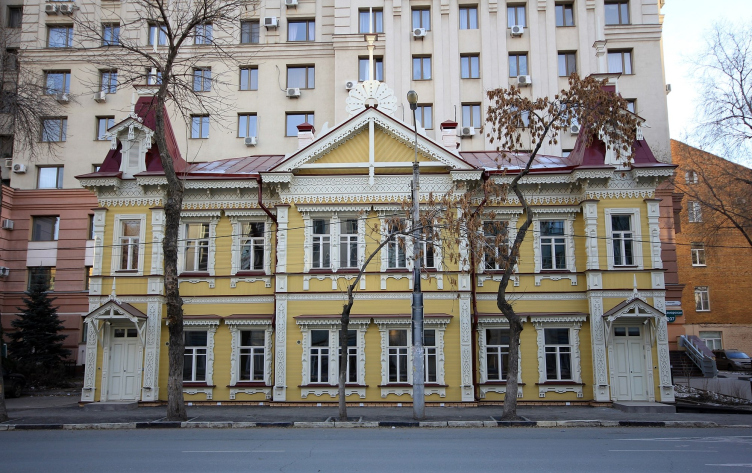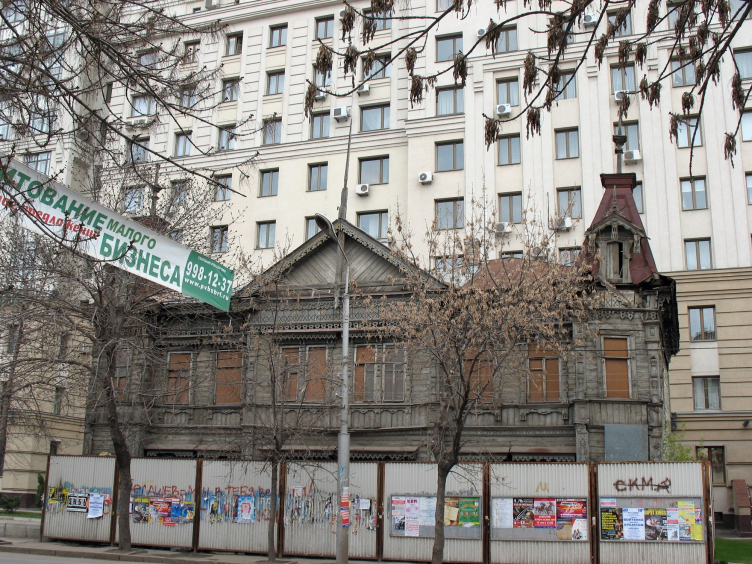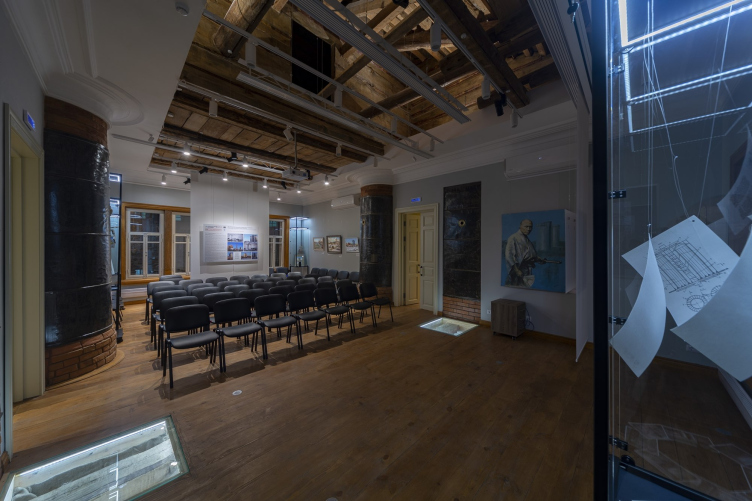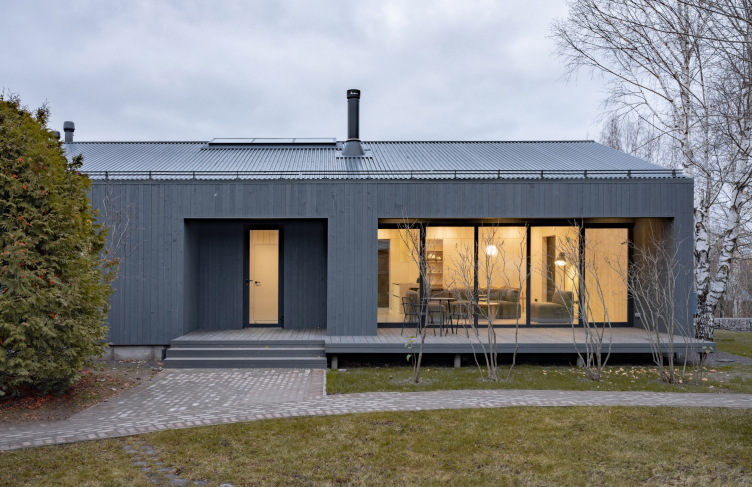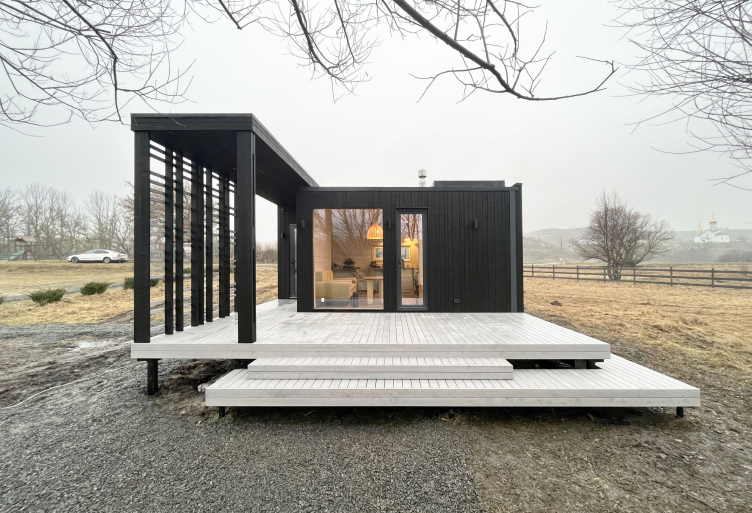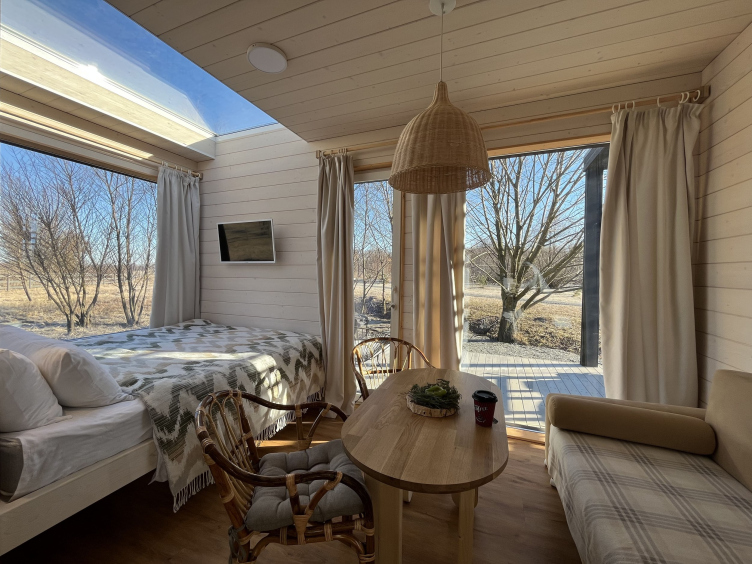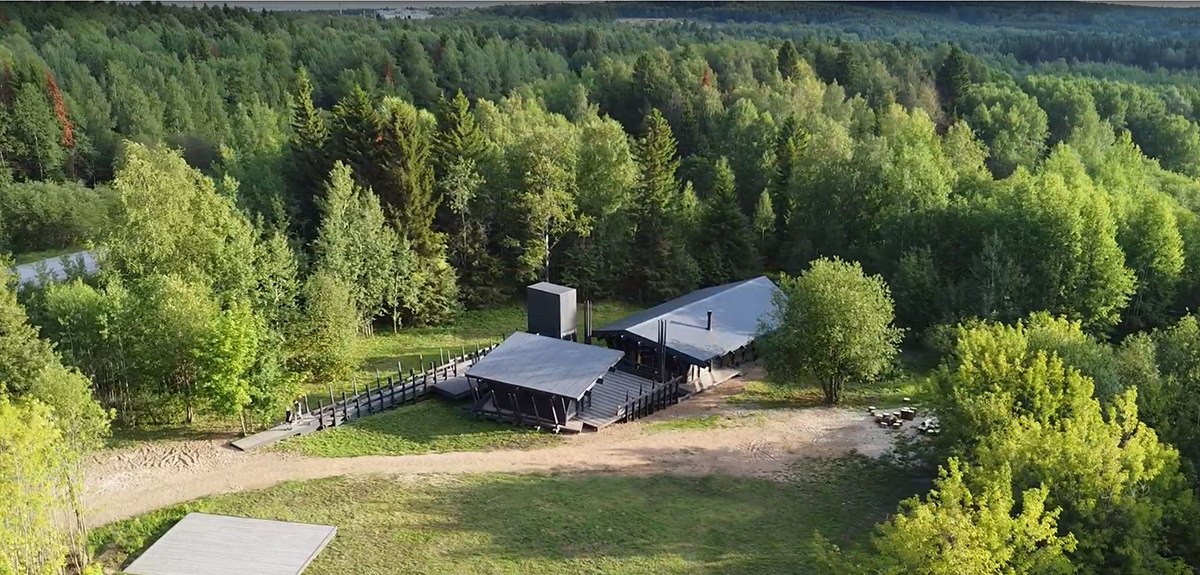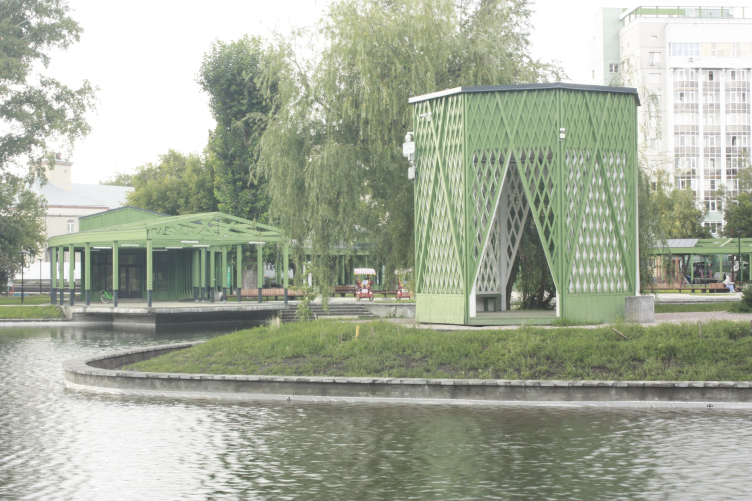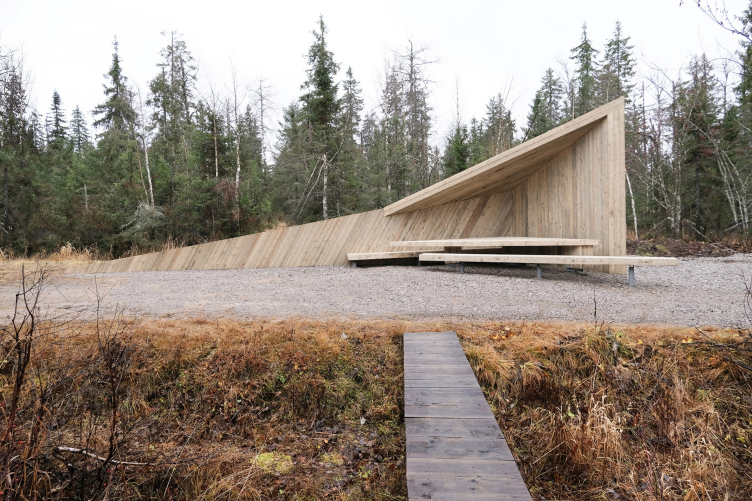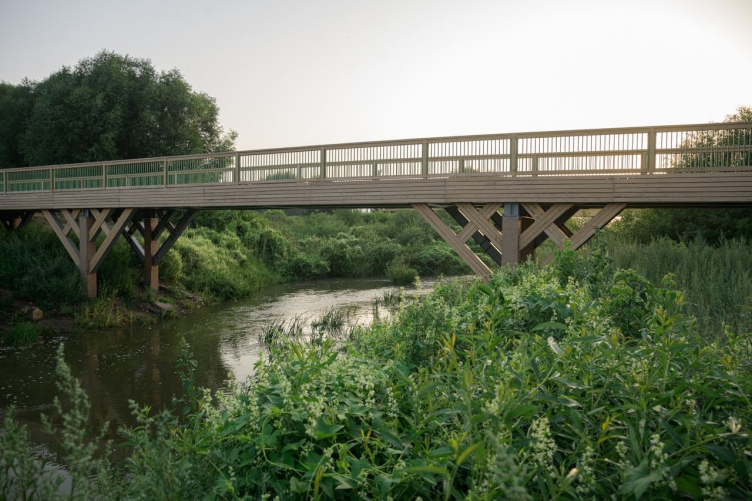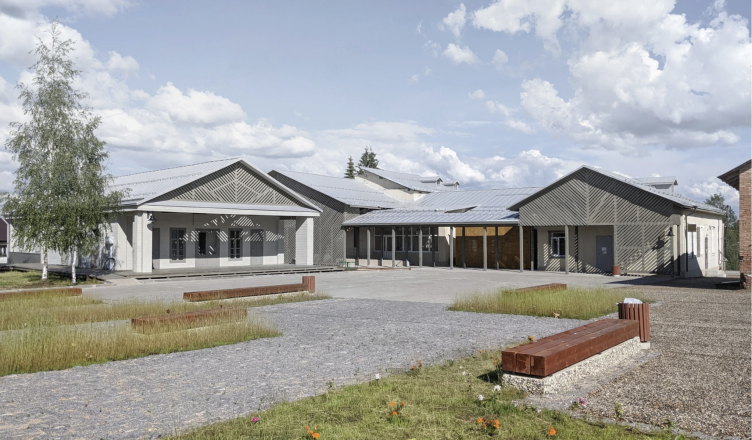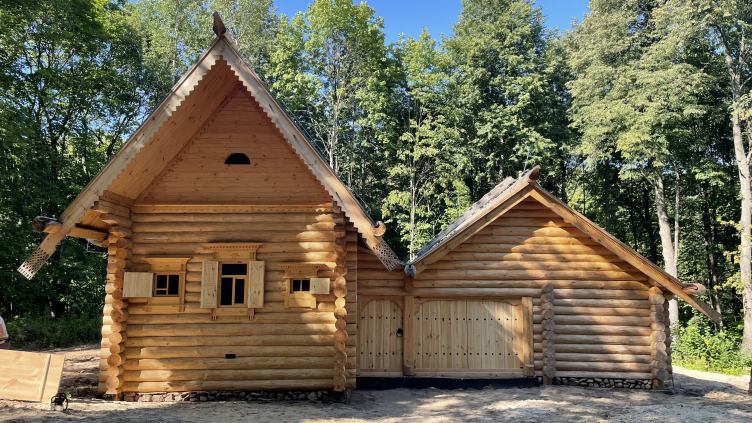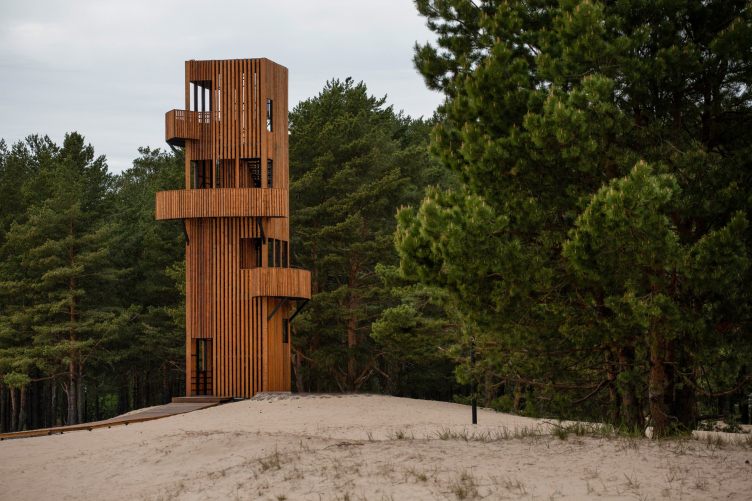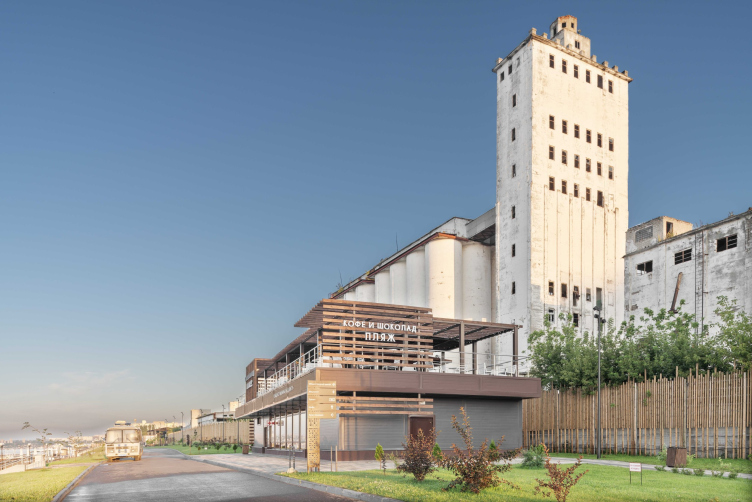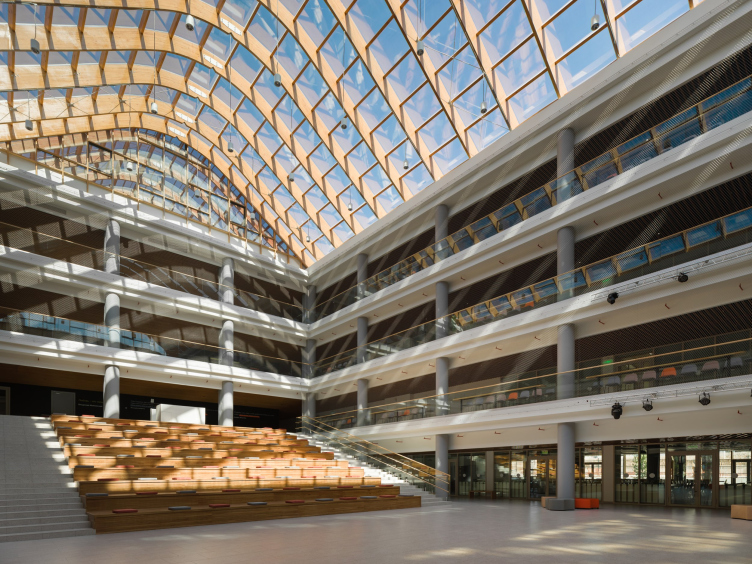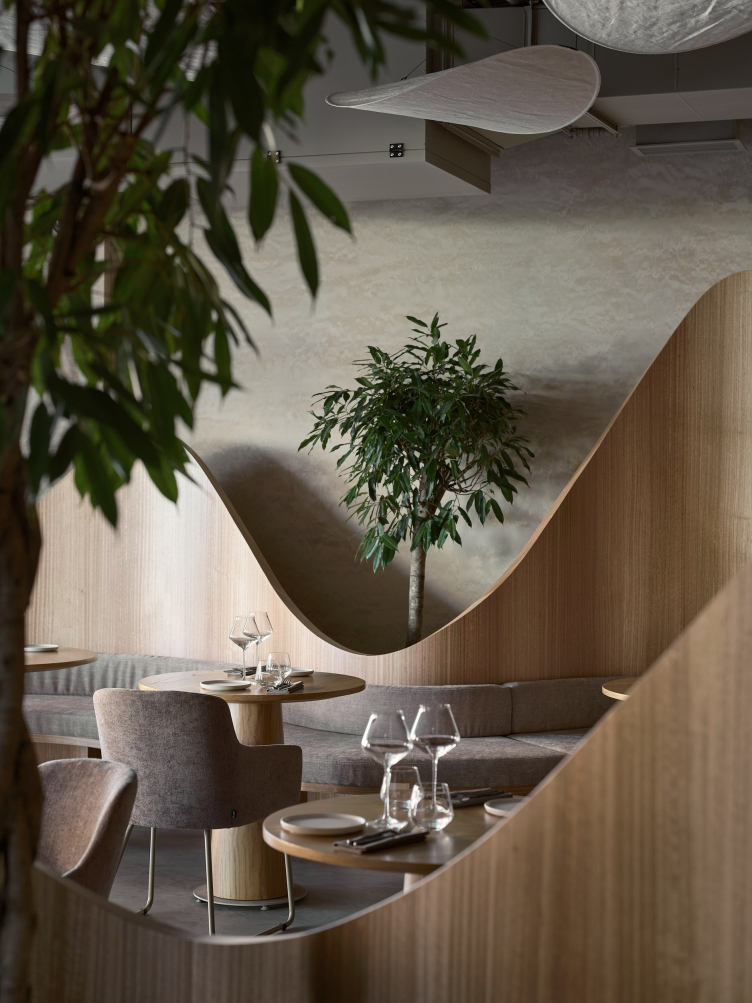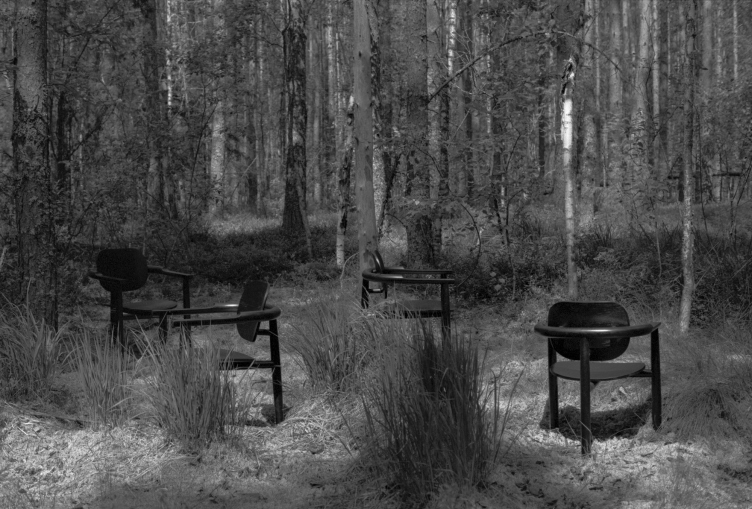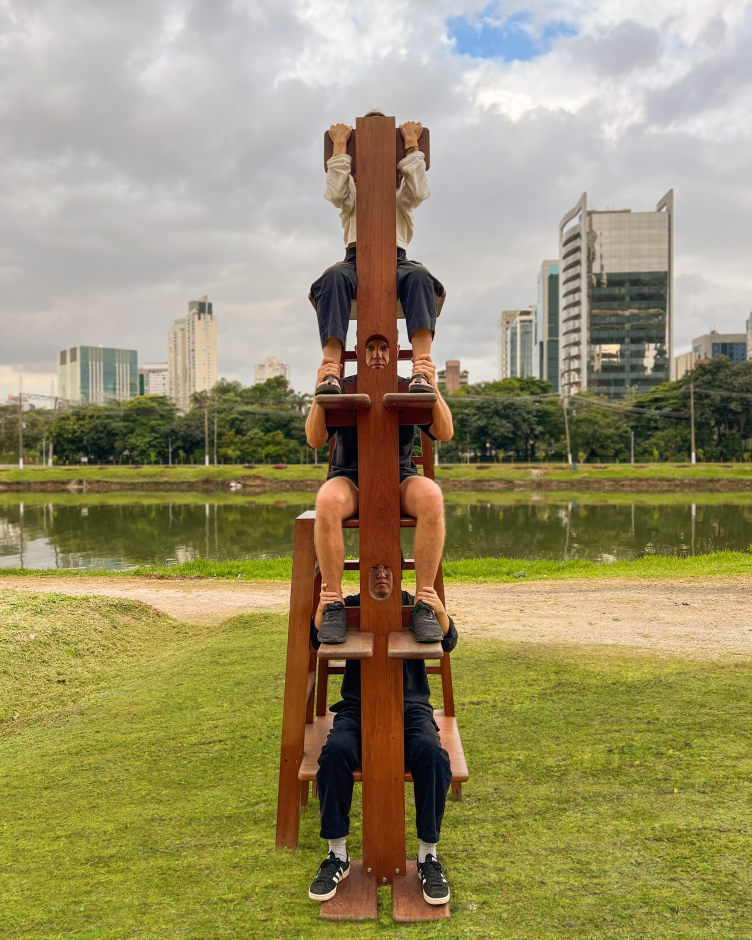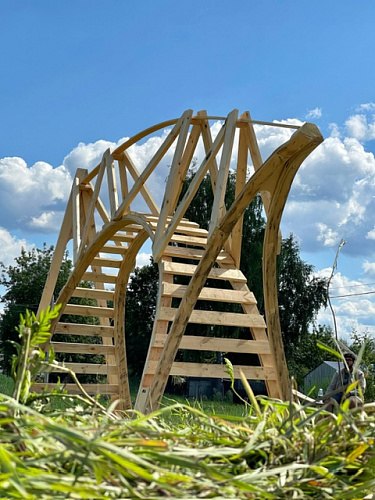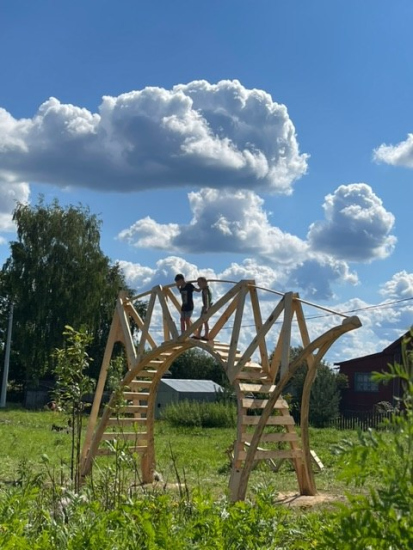The award was curated by the permanent Nikolay Malinin, co-curated by Julia Shishalova, and organized by Rossa Rackenne SPb, which was also the title partner of the event.
Jury’s Special Prize
Gallery Museum “Zavarka” (“Brew”) (Mashtakov House)
All-Russian Society for the Presentation of Historical and Cultural Monuments, Vega Group Region
Khramov Architectural Studio
Creative space concept: Dmitry Khramov, Armen Arutyunov, Nina Kazachkova, Maria Ionova, Anastasia Knor.
Interior design: Dmitry Khramov, Marina Krichanova, Elena Zagorodneva.
Restoration project: Vega Group Region (Alexander Vyazikov, head of the project).
Scientific advice: Andrei Bode (NIITAG).
There is quite an appalling number of beautiful houses of this kind burning and decaying all over Russia, but only a few of them are properly restored and given a new function. The case of the Mashtakov house in Samara is very beautiful: the restorers managed to preserve about 80% of the original structures, some of them becoming living exhibits in the gallery halls on the second floor. The first floor was adapted for a tea room. The revival took place thanks to the care of All-Russian Society for the Presentation of Historical and Cultural Monuments: in 2021, the local branch of the society won the competition of the Presidential Fund for Cultural Initiatives to create a museum gallery named “Zavarka” (“Brew”) in the house. Before that, the mansion by architect Alexander Scherbachev, who “built the better half of old Samara”, had stood behind a blank fence for almost three decades.
You can learn more about the history of the house in the book by Andrei Bode, the scientific director of the restoration project, available on the gallery’s website.
Zavarka Museum (Mashtakov House)
Copyright: Photograph © Dmitry Nedykhalov, Armen Arutyunov / provided by ArchiWOOD
Zavarka Museum (Mashtakov House)
Copyright: Photograph © Dmitry Nedykhalov, Armen Arutyunov / provided by ArchiWOOD
Zavarka Museum (Mashtakov House)
Copyright: Photograph © Dmitry Nedykhalov, Armen Arutyunov / provided by ArchiWOOD
Country house / jury
Delo House 4
Delo Design
On the one hand, it is surprising to see a serial production house chosen by the jury in one of the main nominations, but on the other hand, the house IS really good. The approach of St. Petersburg’s architectural company Delo Design is distinguished by its complexity and perfectionism: you go to the website, choose a model in the catalog, wait four months, and then what you see is what you get – the interiors and even the appliances have already been planned by the designers, everything is in its best place. And the furniture, textiles and tableware are also designed and made by Delo Design. Such a total look may seem impersonal to some, but to others it is a very convenient “package deal”. It is probably not too easy to scale it consistently: one thing is a micro-house, where everything started, and another is a respectable four-bedroom family nest, which has retained its clean lines and style.
Delo House 4
Copyright: Photograph © Viktor Yuliev / provided by Delo Design
Country House / popular vote
NEBO House
Woodbox
The popular vote favored the more affordable and romantic option: its area is 100 m2 less, but everything you want to buy for your first house is in place – the space outside the window, the stars above your head, the stove – in short, “that’s happiness”. The small area of the room, which combines bedroom, kitchen and living room, is compensated by a spacious terrace with a pergola: why sit at home when you can have a great time outside? Oh, and by the way, if you do stay inside, it is still as if you stay outside – two panoramic windows dissolve the boundaries, and the ceiling window “works” even at night. The house is assembled according to the frame-modular technology on a pile foundation in just two days, together with finishing. The facades are clad with black pine.
NEBO House
Copyright: Photo © WOODBOX / provided by ArchiWOOD
NEBO House
Copyright: Photo © WOODBOX / provided by ArchiWOOD
Other shortlisted projects in the Country House category:
Matski House, Zrobim Architects
“Sunflower Seeds” Guest Houses, Vladimir Rusanov
Summer Patio, A4
Arkhsarai, Katya Svanidze design atelier
SWIDOM SW5, MAParchitects
DachaHouse, DK Architects
Guest house with a sauna, Elizaveta Portnova
Glued laminated timber house, Elizaveta Portnova
Trinity, ARCHIWOOD community
Public facilities / jury
Hotel “Igora. Vremena Goda” (The Four Seasons”)
Rhizome
Evgeny Reshetov, Tatiana Sinelnikova, Yana Demina, Ilya Belyakov, Karina Zimina, Olga Markina, Anna Chernoyarova
Rhizome’s projects are both stylish and photogenic: last year’s nomination included “Tochka na Karte” (“Point on the Map”) hotel in Lodeynoye Pole, the conceptual solutions of which the Igora project continues and develops. Just like in “Point on the Map”, the architects are assembling the complex from modules with glued wood construction, turning the blocks in such a way that each room commands a beautiful view of the spruce forest. In addition to 100 rooms, the hotel includes a reception block and a lobby bar. Production from scratch and assembly took nine months.
Igora. Vremena Goda (“The Four Seasons”) hotel
Copyright: Photo © Dmitry Chebanenko / provided by ArchiWOOD
Public facilities / popular vote
Forest club “Tern” (“Blackthorn”)
“Tern” Architectural and Production Studio
Vladimir Lazbinov, Lyudmila Lazbinova
“Tern” is a venue for weddings, corporate parties with karaoke and parties with DJs, located on a forest glade. Half-timbered constructions are quite popular in this typology, but the architects managed to achieve a certain degree of elegance, at the same time creating an atmosphere of an open air event under the roof: from the pavilion and gazebo you can perfectly see the surrounding forest, which has become part of the “decor”. In the evenings, the green “wall” is spectacularly illuminated and adds to the festive mood. The bridge and terrace connect the pavilions and the bathrooms into a single “island” complex named “Winterfell” (sic!) for staff and “Portal” for guests.
TERN forest club
Copyright: Photo © Aleksey Martynyuk / provided by ArchiWOOD
Other shortlisted projects in the Public Facilities category:
Skolkovo Fitness Club, A-Structura, Anna Ulyanova
Book Alleys, spirin architects, Evgeny Spirin, Ekaterina Argutina
Nomad Houses, ZROBIM architects
Botanical greenhouses on the territory of the Arkhangelskoye Estate Museum, Wowhaus
Urban Design / Jury
The nomination boasts the most representative shortlist this year. The projects are really spectacular and diverse: from an impressive park in Nizhny Novgorod to “pinpoint interventions” by Basis architectural studio. For some reason, two expo projects were also included.
Improvement of the historical center of Nikolo-Berezovka village
ANO Institute for the Development of Towns and Villages of Bashkortostan,
Novaya Zemlya LLC,
APRELarchitects,
Project Office LLC
Olga Sarapulova, Almaz Fatkullin, Alexandra Katasonova, Daria Efremova, Grigory Solomin, Almira Gaimaletdinova, Andrey Manakin, Alexander Dvuzhilov, Zhanna Sverchkova, Natalia Bavykina, Galina Volzhanskaya, Veronika Babenko, Olga Razumovskaya, Nikita Belyakov
The jury’s selection of the Nikolo-Berezovka improvement is interesting in terms of working with the lost heritage. Using wooden planks and a simple pavilion, the architects of the APRELarchitects and Novaya Zemlya consortium outline the dimensions of the barn, of which only a fragment of the wall remains. The ruin is accentuated in this way, and without violating the authenticity of the matter and the idea, a new functionality appears: the pavilion has a café, a toilet and shopping stalls. The wood of which the garden structures and decks are made has become the main material uniting the historical buildings strung along the Big Merchant Street, the main promenade of the village. The beauty of the pond near St. Nicholas Church was emphasized by a spectacular yet tasteful round bridge.
Improvement of the historical center of Nikolo-Berezovka village
Copyright: Photo © Institute of Urban Development of Bashkortostan / provided by ArchiWOOD
Urban Design / popular vote
Pavilions in Izumrudny Park
MDVAstudio
Dmitry Indyukov, Maxim Maksimenko, Evgeny Makarenko, Olesya Petukhova, Yulia Titova
The people’s choice, probably, reflects people’s fatigue from the mass improvement of recent years, made in the all-too familiar “stylish, fashionable, youthful” spirit. In Barnaul’s Izumrudny Park, however, the approach is almost the opposite: the new objects remind of dance floors, popsicles and schoolgirls in starched aprons, but look surprisingly charming and fresh. Although they noticeably echo, in color and lattice, the objects of the Switzerland Park in Nizhny Novgorod, designed by KOSMOS.
Pavilions in the Izumrudny City Park
Copyright: Photo © Dmitry Indyukov / provided by ArchiWOOD
Other shortlisted projects in the Urban Design category:
Exposition “Rays”, Vlad Savinkin
Central Park of Culture and Recreation in Istra, Basis architectural studio
Lipovaya Grove, Basis architectural bureau
Territory of Arkhangelskoye Estate Museum, Wowhaus
Exhibition “Event Horizons”, Totan Kuzembaev architectural studio
Melnikoff/Melnikoff exhibition, Planet 9
Museum Quarter in Gorodets, Institute of Urban Environment Development of Nizhny Novgorod Region, Kurt studio
Park of the 800th Anniversary of Nizhny Novgorod, Institute of Urban Environment Development of Nizhny Novgorod Region, Arch Group
Small object / jury
Apex
Ad Hoc Architecture
Stanislav Subbotin, Daria Kirillova
The pavilion is installed at the beginning of the trail leading to the summit of the Northern Baseg, the highest point in the western Middle Urals. It provides the traveler with a place to rest and shelter from the rain, but it also sets the mood for the road and promises something special: not every trail gets such an expressive symbol. The outlines are reminiscent of ridges, and the boards have been artificially aged to better match the colors of the surroundings.
Improvement of the eco-path “To the top of the Northern Baseg”
Copyright: Photograph © Ad Hoc Architecture
Small object / popular vote
Pedestrian bridge over the Kazanka River
M2M3 architectural studio
Eduard Gubeev, Marsel Kayumov, Tansylu Khakimova (M2M3 architectural studio). Curator: Institute of Urban Development of the Republic of Tatarstan
The choice of the people is again great and seems more justified than that of the jury. The wooden bridge over the Kazanka River in Arsk restores the 19th century crossing and revitalizes the peripheral district. The structures are fascinating: the supports simultaneously resemble fragments of national ornaments and tree trunks.
Pedestrian bridge over the Kazanka River
Copyright: Photograph © Daniil Shvedov / предоставлена ArchiWOOD
Other shortlisted projects in the Small object category:
Tree House, ProstoDom
Besedki-Snopy, TM Design Studio
Radiant pavilion, Architectural studio LATOON
***
The Restoration nomination was not originally present in the ArchiWOOD awards, and it is certainly different from all the others, as it is not dedicated to modern architecture and design, but to working with architectural heritage, which, as you know, is, firstly, poorly financed and therefore goes by the wayside, and if it is well financed, it often bears some poisonous fruit. Secondly, it requires not so much creative impulse and artistic freedom, but rather research, meticulousness, careful attitude to authenticity – completely different qualities.
Since it has been introduced, the nomination adorns the prize, but its life is complicated, just like the life of good restorers: the works are difficult to collect, and they must be judged according to different criteria.
In short, this year, based on the specifics of the material, the expert council of the prize decided to rename the nomination, expanding its genre boundaries – both reconstruction and recreation were added here. So they won: one reconstruction with adaptation and one recreation.
We cannot entirely rule out the possibility that next year “pure” restoration will be brought back – again based on the specifics of the material.
Restoration, reconstruction and re-creation / jury
Renovation of public buildings in Ferapontovo
APRELarchitects
Mikhail Razumovsky, Alexey Fatkin, Galina Volzhanskaya, Veronika Babenko, Anastasia Markina
Another work by APRELarchitects, made for an incredibly obliging location – the Ferapontov Monastery, which can be safely classified as one of those sights worth seeing at least once in your life. The village near the monastery somewhat smeared the impression of the harmony of the place, but now the environment is more integral: with the help of wooden lattice elements, the architects transform the main square into a unified ensemble. The landscaping is delicate and practical – the services it provides are important for both tourists and locals, who have an additional opportunity to earn a living and enjoy their leisure time here.
Renovation of public buildings in Ferapontovo
Copyright: Photo © APRELarchitects / provided by ArchiWOOD
Restoration, reconstruction and re-creation / popular vote
Saltykova House
VAIMA
Anton Myakishev, Evgeny Rakov (on-site work)
The “People” voted in favor of recreating the late 18th century Saltykova’s house, which burned down by vandals, located on the territory of the Shchelkovsky Khutor Museum of Wooden Architecture. The Vaima specialists used nails, hand-forged fittings, and hand planers for the complex profiles of the elements.
Saltykova House
Copyright: Photo © Anton Myakishev / provided by ArchiWOOD
Other shortlisted projects in the Restoration category:
Dome of Levashov bakery, Rus Corporation commissioned by RBI Group
Zavarka Museum and Gallery, All-Russian society for the Preservation of Historical and Cultural Monuments, Vega Group Region, Khramov Architectural Studio
Residential house of the 1880s on Volodarskogo Street, Architectural Restoration Workshop-10
Residential house of the early twentieth century on 64 Sedov Street, Architectural Restoration Workshop-10
Early 20th century manor house on Rabochego Shtaba Street, 4, Architectural Restoration Workshop-10
Wood in decoration / jury
Observation tower in Svyastroy
NTML Architects
Authors: Nikita Timonin, Maria Lyashko
Wood in decoration / popular vote
Administrative building on Novaya Naberezhnaya
Project Proposals Division of the Urban Design Department of the Architecture Committee of the Saratov City Municipal Administration.
Authors: Project Proposals Department of the Urban Design Department of the Committee for Architecture of the Administration of the Municipal Entity “Saratov City” (concept stage). MKU “Capital Construction” (project stage)
Sosnovy Bor Park in the town of Svyastroy
Copyright: Photo © Leningrad Region Competence Center / provided by NTML architects
Other shortlisted projects in the Wood in Decoration category:
Modernist villas near Nizhny Tagil, architectural company Gordeev-Demidov
Interior / jury
School in the Evrobereg district
SVESMI, Brusnika, Novascape
Administrative building on Novaya Naberezhnaya
Copyright: Photo © Dmitry Shvedov / provided by ArchiWOOD
Quite a famous school, designed in the spirit of modern trends, defined by everyone’s fatigue of the recently-popular garish design, as well as by attention to public spaces, where children communicate and socialize in an environment close to the natural one. The various features of the school building, such as the brick facade with stair towers at the corners, exposed concrete, and flowing light spaces, are subtly complemented by wood, one of the natural materials used here in the interior. The wooden beams of the atrium’s glass ceiling are a highlight.
Interior / popular vote
Wine bar
Daria Volkova Design
Author: Daria Volkova
Other shortlisted projects in the Interior category:
A house for granddaughter, ADK-studio
Capsule sleeping rooms for a children’s camp, Mera Makers
Interior of a children’s room, Alexey Rosenberg’s studio
Be.St.Be Smart House, PROEKTOR
Seven Stars Kindergarten, Unison Design Studio
Ryotei Restaurant in the Japanese Garden, RYMAR.studio
Object Design / Jury and the popular vote
The series “Ostov” (“Island”)
NODE, Alexander Frucht, Nikolay Bugrov
The school in “Evrobereg” district
Copyright: Photograph © Dmitry Chebanenko / provided by Brusnika
Other shortlisted projects in the Object Design category:
Tatami-Chair-Tatami, Ekaterina Solovieva
REBBIT table lamp, MDM-Light
Closet-bar, architectural studio LATOON
Hangers, Institute of Business and Design, Architectural Environment and Design Profile
Art object / jury
Antifurniture
Treivas
Authors: Olga Treivas, Fedor Pavlov-Andreevich, Elena Kornilova, Maya Rozhnovskaya, Lisa Narutskaya, Elena Kovalenko
Wine bar
Copyright: Photo © Dmitry Tsyrenshchikov / provided by ArchiWOOD
Art object / popular vote
Pasture
std group, Vladimir Grishin, Nikolay Gedevanishvili, Gor Hovsepyan, Ahmed Omarov, Ani Khachaturyan
The “Island” series from NODE
Copyright: Photo © NODE / provided by ArchiWOOD
Other shortlisted projects in the Art Object category:
The Gap – burning the fourth wall, NOYD
Cabin #29: Zavolzhsky Man camp site (homo flumen), TM Design Studio
Near and Far, 0806.studio
New Year’s tree, Institute of Business and Design,Vlad Savinkin.
Arctic Meadow, Chekharda, architects of Artemy Lebedev Studio
Archive, DoBuro
Ray, Inna Vlasova, Natalia Sorokina, Maria Bartel, Victoria Guskova
Fortress, VOSEM (“EIGHT”) Crew
Anti-furniture
Copyright: Photo by Dmitry Markin, Filipe Conde, Elissa Thiele / provided by Treivas


